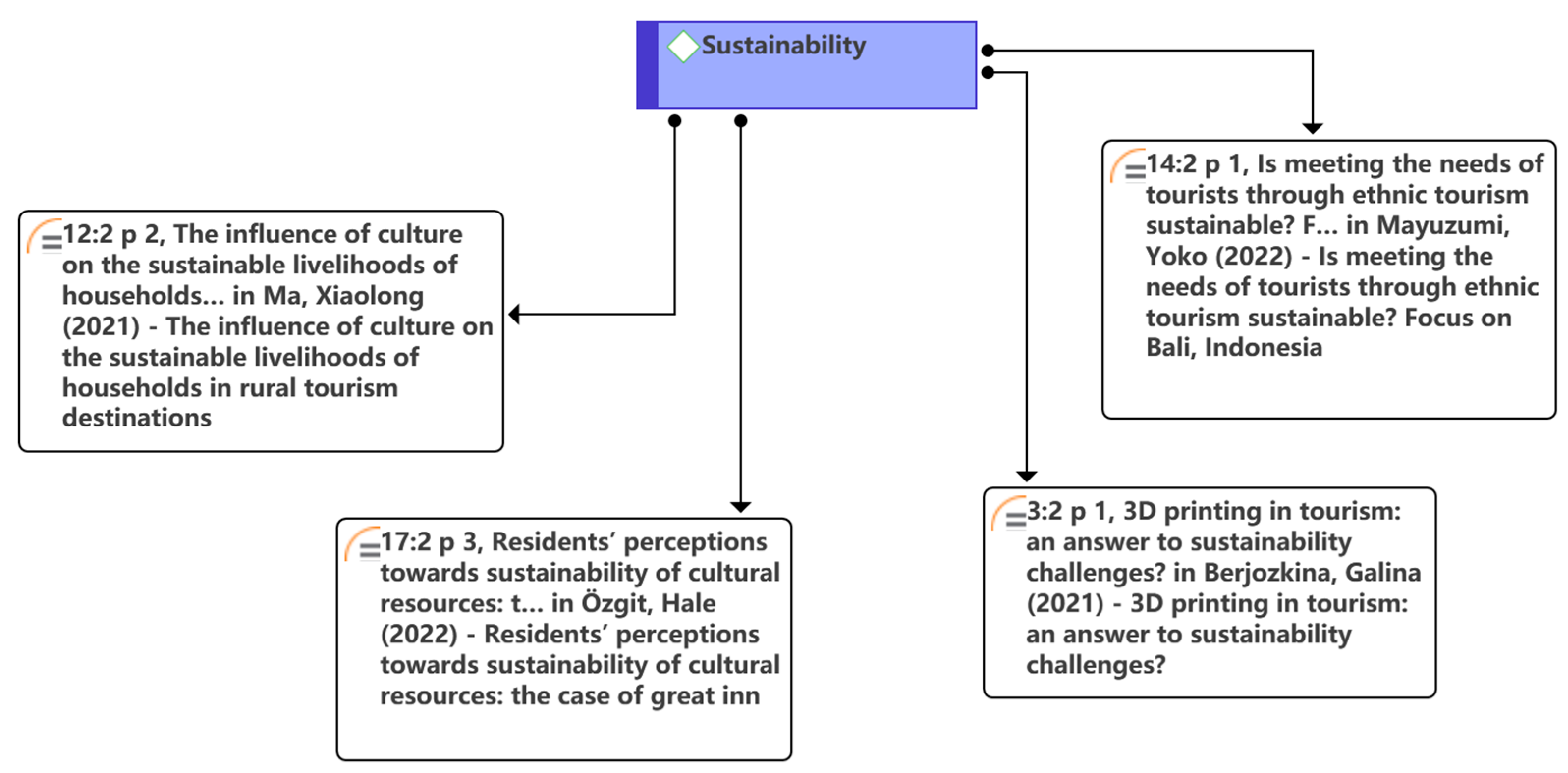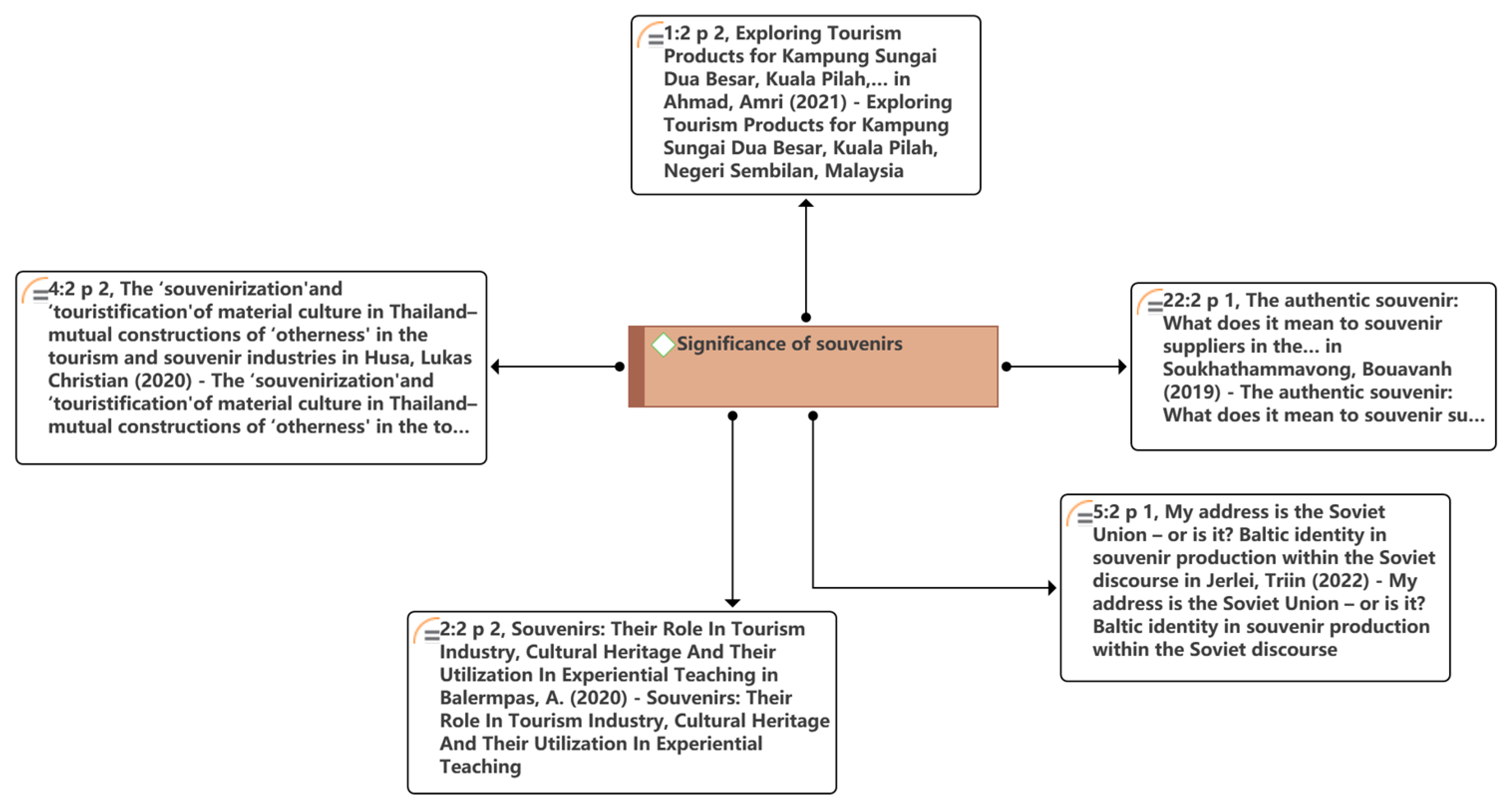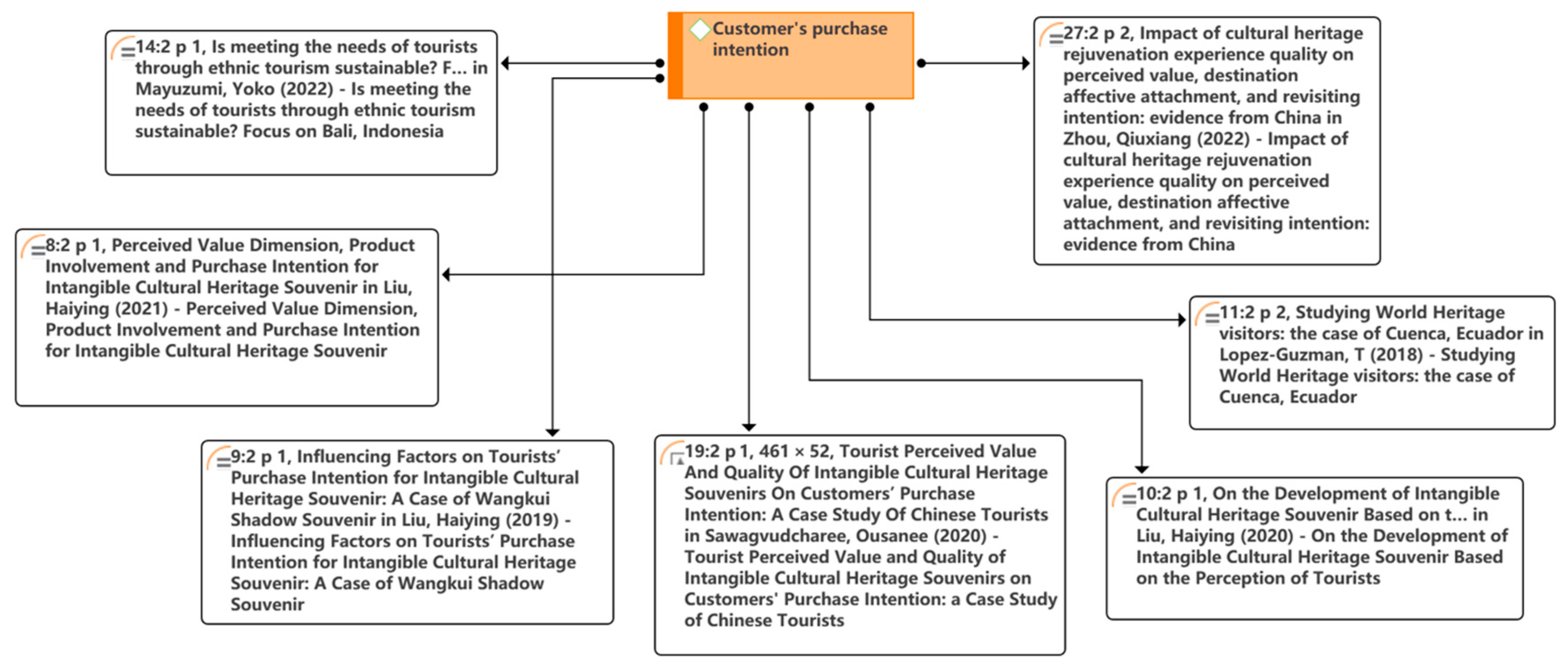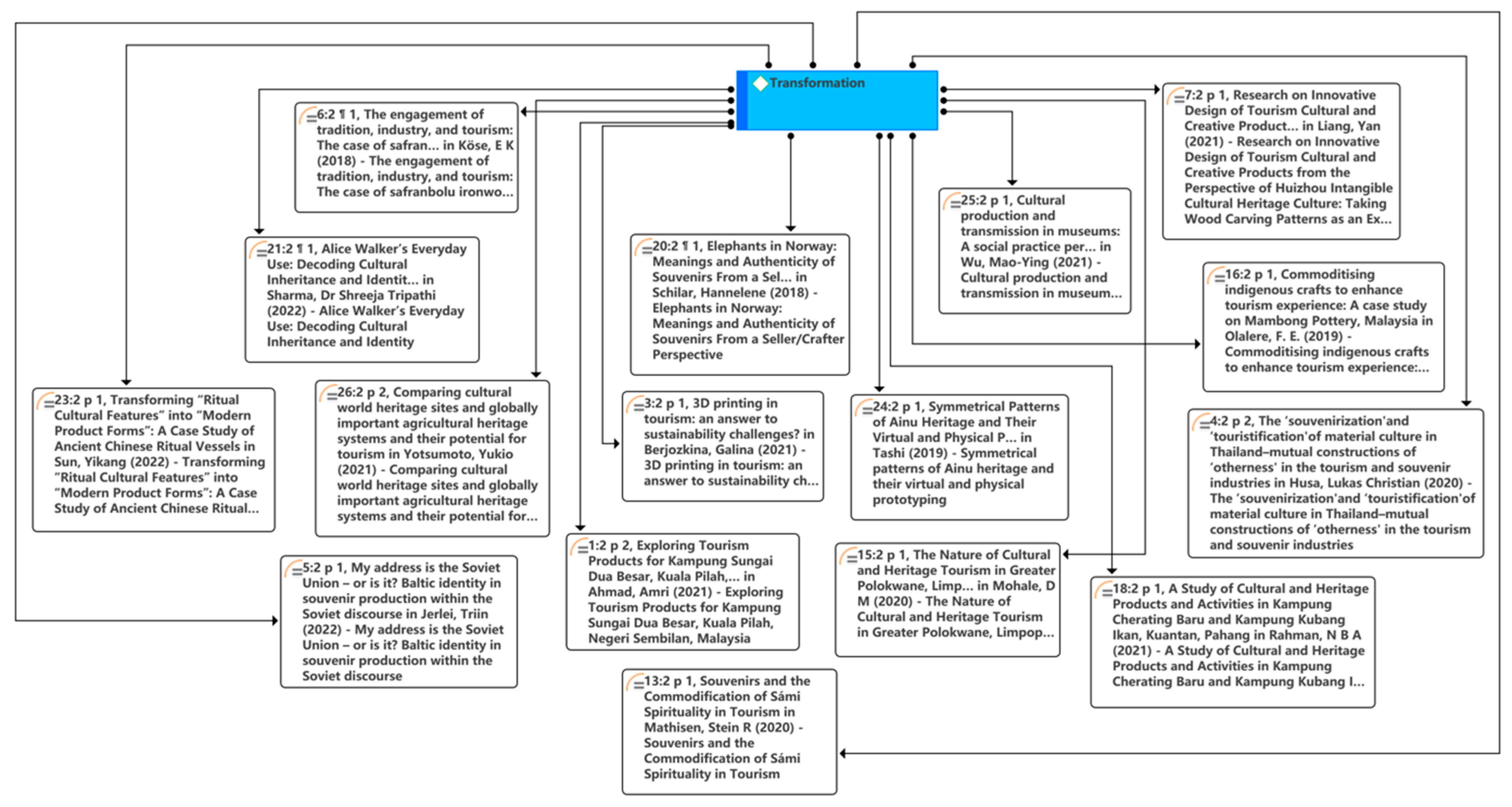Souvenirs Development Related to Cultural Heritage: A Thematic Review
Abstract
1. Introduction
2. Literature Review and Research Aim
2.1. The Role of Cultural Heritage
2.2. Commercialization of Cultural Heritage
2.3. Preservation and Conservation
2.4. Relationship between the Souvenirs and Cultural Heritage
2.5. Research Aim
3. Materials and Methods
4. Results and Discussion
4.1. Quantitative Findings
4.2. Qualitative Results
4.2.1. Theme 1: Significance of Souvenirs
4.2.2. Theme 2: Customer’s Purchase Intention
4.2.3. Theme 3: Transformation
- Production techniques
- Value transmission
4.2.4. Theme 4: Sustainability (Figure 9)
5. A Conceptual Framework for Transforming Cultural Heritage into Souvenirs
- Significance of souvenirs—to focus on souvenir value, role, and innovation related to cultural heritage.
- Customer’s purchase intention—to understand the relationship between consumer needs, perceived value, product innovation, and cultural heritage.
- Transformation—to conduct in-depth research on souvenir production techniques and to focus on how to transmit value.
- Sustainability—to create new values of cultural heritage in product development and strategy to better preserve cultural heritage in the premise of its commercialization.
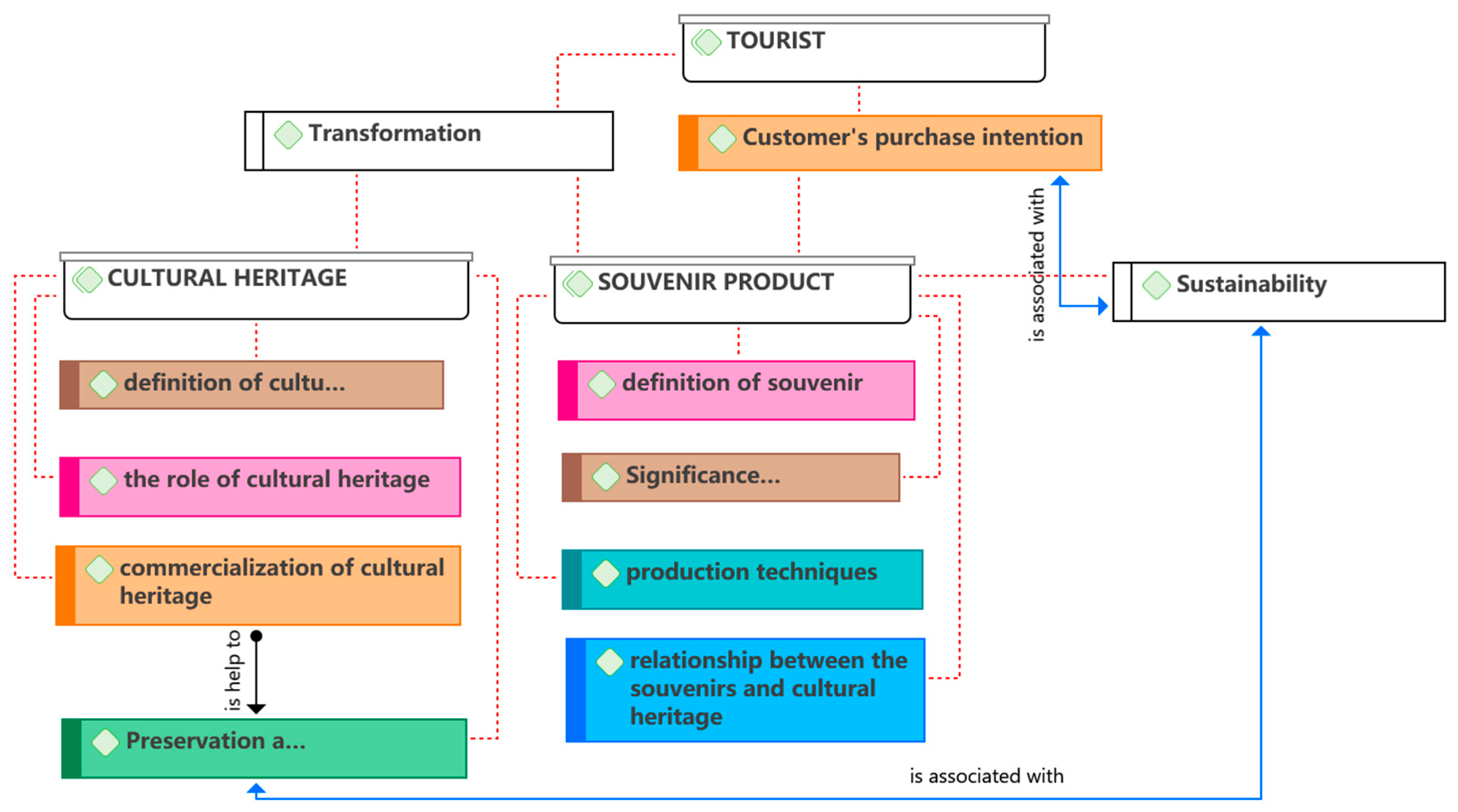
6. Conclusions
Author Contributions
Funding
Institutional Review Board Statement
Informed Consent Statement
Data Availability Statement
Acknowledgments
Conflicts of Interest
References
- Lopez-Guzman, T.; Gálvez, J.C.P.; Fernández, G.A.M.; León, L.T. Studying World Heritage visitors: The case of Cuenca, Ecuador. J. Cult. Herit. Manag. Sustain. Dev. 2018, 8, 372–386. [Google Scholar] [CrossRef]
- Littrell, M.A. Shopping experiences and marketing of culture to tourists. In Tourism and Culture: Image, Identity and Marketing; University of Northumbria, Centre for Travel and Tourism: Newcastle upon Tyne, UK, 1996; pp. 107–120. [Google Scholar]
- Carson, D.; Prideaux, B.; Coghlan, A.; Taylor, A. Heritage as a motivation for four-wheel-drive tourism in desert Australia. J. Herit. Tour. 2009, 4, 217–225. [Google Scholar] [CrossRef]
- Mathisen, S.R. Souvenirs and the Commodification of Sámi Spirituality in Tourism. Religions 2020, 11, 429. [Google Scholar] [CrossRef]
- Olalere, F.E. Commoditising indigenous crafts to enhance tourism experience: A case study on Mambong Pottery, Malaysia. Afr. J. Hosp. Tour. Leis. 2019, 8, 1–11. [Google Scholar]
- Manola, M.; Balermpas, A. Souvenirs: Their Role in Tourism Industry, Cultural Heritage and Their Utilization in Experiential Teaching. Arch. Bus. Res. 2020, 8, 1–10. [Google Scholar]
- Sharma, S.T. Alice Walker’s Everyday Use: Decoding Cultural Inheritance and Identity. Smart Moves J. Ijellh 2022, 10, 103–109. [Google Scholar] [CrossRef]
- Ashworth, G.J. From History to Heritage—From Heritage to Identity; Routledge: London, UK, 2013. [Google Scholar]
- Evans-Pritchard, D. Ancient art in modern context. Ann. Tour. Res. 1993, 20, 9–31. [Google Scholar] [CrossRef]
- Mohale, D.M.; McKay, T.; van der Merwe, C.D. The Nature of Cultural and Heritage Tourism in Greater Polokwane, Limpopo, South Africa. Afr. J. Hosp. Tour. Leis. 2020, 9, 930–943. [Google Scholar] [CrossRef]
- Tashi; Ullah, A.S. Symmetrical Patterns of Ainu Heritage and Their Virtual and Physical Prototyping. Symmetry 2019, 11, 985. [Google Scholar] [CrossRef]
- Liang, Y.; Qi, Z. Research on Innovative Design of Tourism Cultural and Creative Products from the Perspective of Huizhou Intangible Cultural Heritage Culture: Taking Wood Carving Patterns as an Example. Sci. Soc. Res. 2021, 3, 228–232. [Google Scholar] [CrossRef]
- Husa, L.C. The ‘souvenirization’ and ‘touristification’ of material culture in Thailand—Mutual constructions of ‘otherness’ in the tourism and souvenir industries. J. Herit. Tour. 2019, 15, 279–293. [Google Scholar] [CrossRef]
- Lin, Transforming Taiwan aboriginal cultural features into modern product design: A case study of a cross-cultural product design model. Int. J. Des. 2007, 1, 45–53.
- Soukhathammavong, B.; Park, E. The authentic souvenir: What does it mean to souvenir suppliers in the heritage destination? Tour. Manag. 2018, 72, 105–116. [Google Scholar] [CrossRef]
- Ahmad, A.; Barakbah, S.M.B.S.F.; Fauzi, M.A.F.M. Exploring Tourism Products for Kampung Sungai Dua Besar, Kuala Pilah, Negeri Sembilan, Malaysia. Webology 2021, 18, 13–22. [Google Scholar] [CrossRef]
- Zhou, Q.; Pu, Y. Impact of cultural heritage rejuvenation experience quality on perceived value, destination affective attachment, and revisiting intention: Evidence from China. Asia Pac. J. Tour. Res. 2022, 27, 192–205. [Google Scholar] [CrossRef]
- Bullen, P.A.; Love, P.E.D. Adaptive reuse of heritage buildings. Struct. Surv. 2011, 29, 411–421. [Google Scholar] [CrossRef]
- Wu, M.-Y.; Tong, Y.; Wall, G.; Ying, T. Cultural production and transmission in museums: A social practice perspective. Ann. Tour. Res. 2021, 87, 103130. [Google Scholar] [CrossRef]
- Ma, X.; Wang, R.; Dai, M.; Ou, Y. The influence of culture on the sustainable livelihoods of households in rural tourism destinations. J. Sustain. Tour. 2020, 29, 1235–1252. [Google Scholar] [CrossRef]
- Holder, A.; Ruhanen, L. Identifying the relative importance of culture in Indigenous tourism experiences: Netnographic evidence from Australia. Tour. Recreat. Res. 2017, 42, 316–326. [Google Scholar] [CrossRef]
- Özgit, H.; Yücelen, Ç.; Güden, N.; Ilkhanizadeh, S. Residents’ perceptions towards sustainability of cultural resources: The case of great inn. J. Tour. Cult. Chang. 2022, 1–16. [Google Scholar] [CrossRef]
- Rahman, A.R.A.; Abedini, A. Design elements regarding to cultural factors of iranian carpet. Alam Cipta 2017, 10, 17–22. [Google Scholar]
- Schilar, H.; Keskitalo, E.C.H. Elephants in Norway: Meanings and Authenticity of Souvenirs from a Seller/Crafter Perspective. Tour. Cult. Commun. 2018, 18, 85–99. [Google Scholar] [CrossRef]
- Yotsumoto, Y.; Vafadari, K. Comparing cultural world heritage sites and globally important agricultural heritage systems and their potential for tourism. J. Herit. Tour. 2020, 16, 43–61. [Google Scholar] [CrossRef]
- Liu, H.; Bunchapatanasakda, C.; Zhang, C.; Zhao, S.; Wang, D. Influencing Factors on Tourists’ Purchase Intention for Intangible Cultural Heritage Souvenir: A Case of Wangkui Shadow Souvenir. Mod. Econ. 2019, 10, 2264–2282. [Google Scholar] [CrossRef]
- Mayuzumi, Y. Is meeting the needs of tourists through ethnic tourism sustainable? Focus on Bali, Indonesia. Asia-Pac. J. Reg. Sci. 2021, 6, 423–451. [Google Scholar] [CrossRef]
- Clarke, V.; Braun, V. Teaching thematic analysis: Overcoming challenges and developing strategies for effective learning. Psychologist 2013, 26, 120–123. [Google Scholar] [CrossRef]
- Braun, V.; Clarke, V. Using thematic analysis in psychology. Qual. Res. Psychol. 2006, 3, 77–101. [Google Scholar] [CrossRef]
- Zairul, M. A thematic review on student-centred learning in the studio education. J. Crit. Rev. 2020, 7, 504–511. [Google Scholar] [CrossRef]
- Sun, Y.; Wu, I.-W.; Lin, R. Transforming “Ritual Cultural Features” into “Modern Product Forms”: A Case Study of Ancient Chinese Ritual Vessels. Religions 2022, 13, 517. [Google Scholar] [CrossRef]
- Liu, H. Perceived Value Dimension, Product Involvement and Purchase Intention for Intangible Cultural Heritage Souvenir. Am. J. Ind. Bus. Manag. 2021, 11, 76–91. [Google Scholar] [CrossRef]
- Berjozkina, G.; Karami, R. 3D printing in tourism: An answer to sustainability challenges? Worldw. Hosp. Tour. Themes 2021, 13, 773–788. [Google Scholar] [CrossRef]
- Jerlei, T. My address is the Soviet Union—Or is it? Baltic identity in souvenir production within the Soviet discourse. J. Mater. Cult. 2021, 27, 147–165. [Google Scholar] [CrossRef]
- Köse, E.K.; Akbulut, D. The Engagement of Tradition, Industry, and Tourism: The Case of Safranbolu Ironworking. Int. J. Des. Soc. 2018, 12, 13–27. [Google Scholar] [CrossRef]
- Liu, H.; Han, F.; Wang, J. On the Development of Intangible Cultural Heritage Souvenir Based on the Perception of Tourists. J. Serv. Sci. Manag. 2020, 13, 345–356. [Google Scholar] [CrossRef]
- Rahman, N.B.A.; Shamsudin, S.N.; Kong, C.S. A Study of Cultural and Heritage Products and Activities in Kampung Cherating Baru and Kampung Kubang Ikan, Kuantan, Pahang. Int. J. Early Child. Spéc. Educ. 2021, 13, 172–182. [Google Scholar] [CrossRef]
- Sawagvudcharee, O.; Liu, H.; Zhang, C. Tourist Perceived Value and Quality of Intangible Cultural Heritage Souvenirs on Customers’ Purchase Intention: A Case Study of Chinese Tourists. Int. J. Econ. Bus. Manag. Res. 2020, 4, 181–195. [Google Scholar]
- Maoz, D. The mutual gaze. Ann. Tour. Res. 2006, 33, 221–239. [Google Scholar] [CrossRef]
- Correia, A.; Kozak, M.; Ferradeira, J. From tourist motivations to tourist satisfaction. Int. J. Cult. Tour. Hosp. Res. 2013, 7, 411–424. [Google Scholar] [CrossRef]
- Chen, C.-S.; Chiu, Y.-H.; Tsai, L. Evaluating the adaptive reuse of historic buildings through multicriteria decision-making. Habitat Int. 2018, 81, 12–23. [Google Scholar] [CrossRef]
- Qiuxia, Z.; Rahman, A.R.A.; Wenhong, H. A thematic review on souvenirs from design perspective publications from 2012–2022: Analysis of trends for future studies. Cogent Arts Humanit. 2022, 9, 2100129. [Google Scholar] [CrossRef]
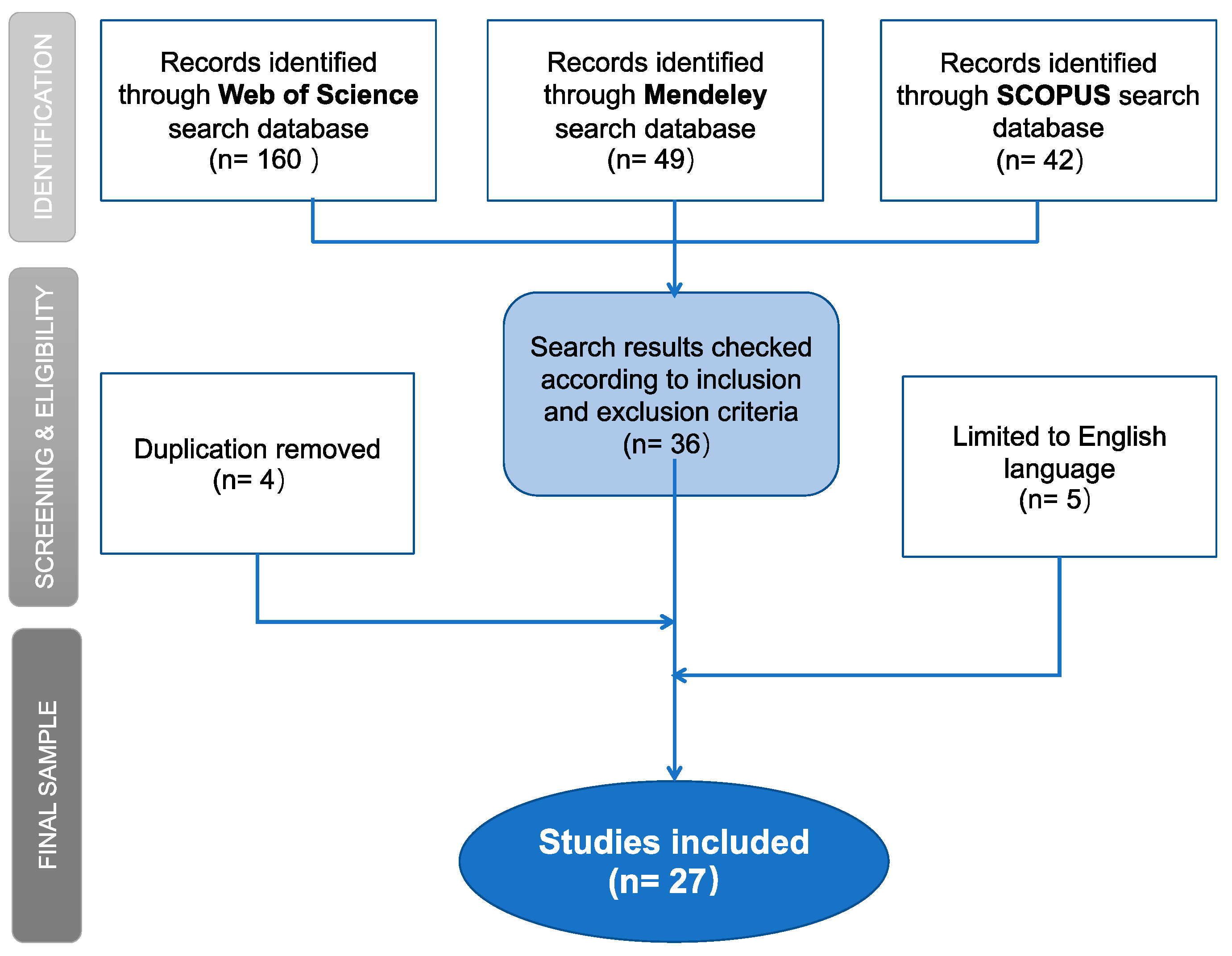
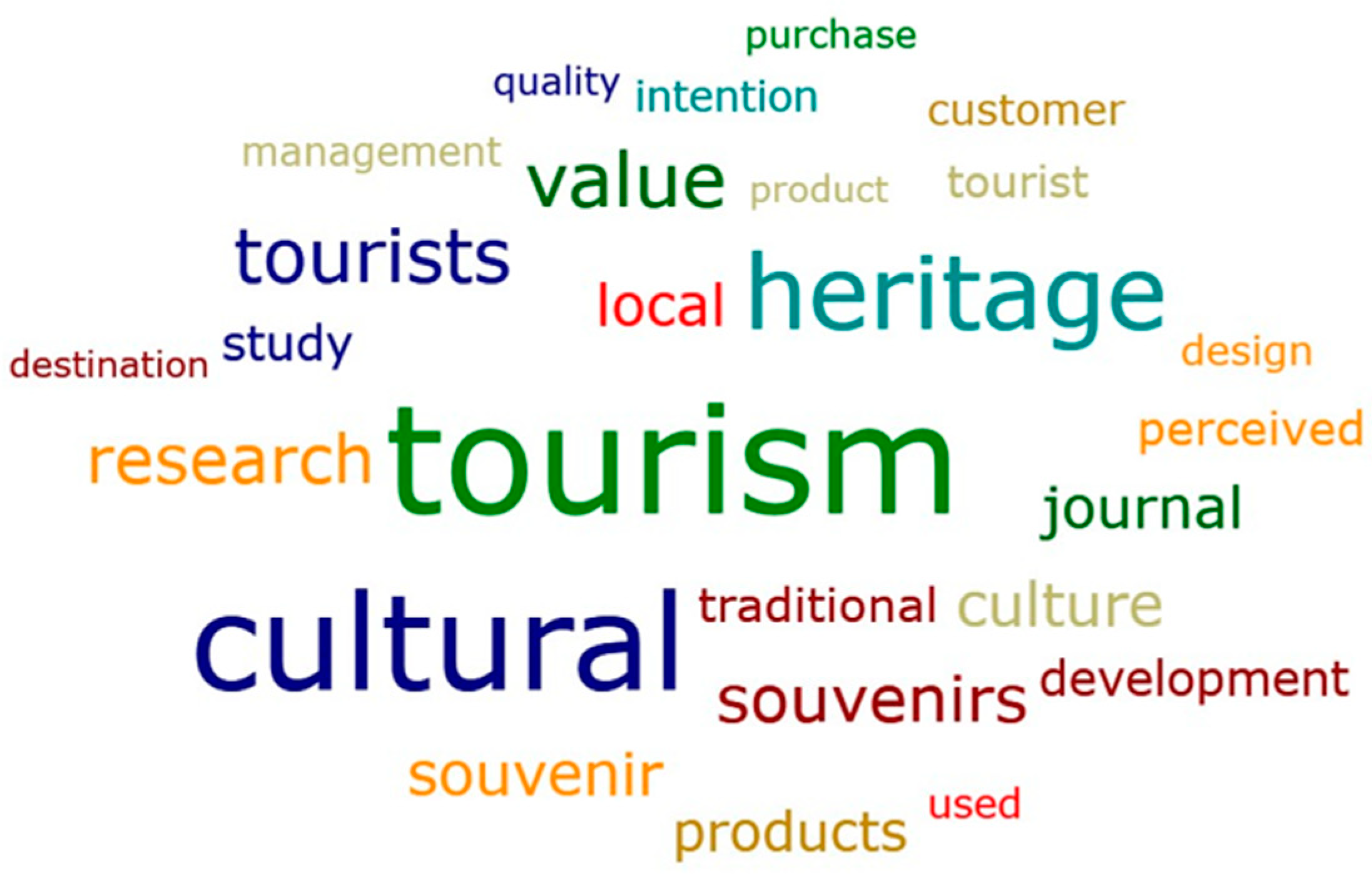
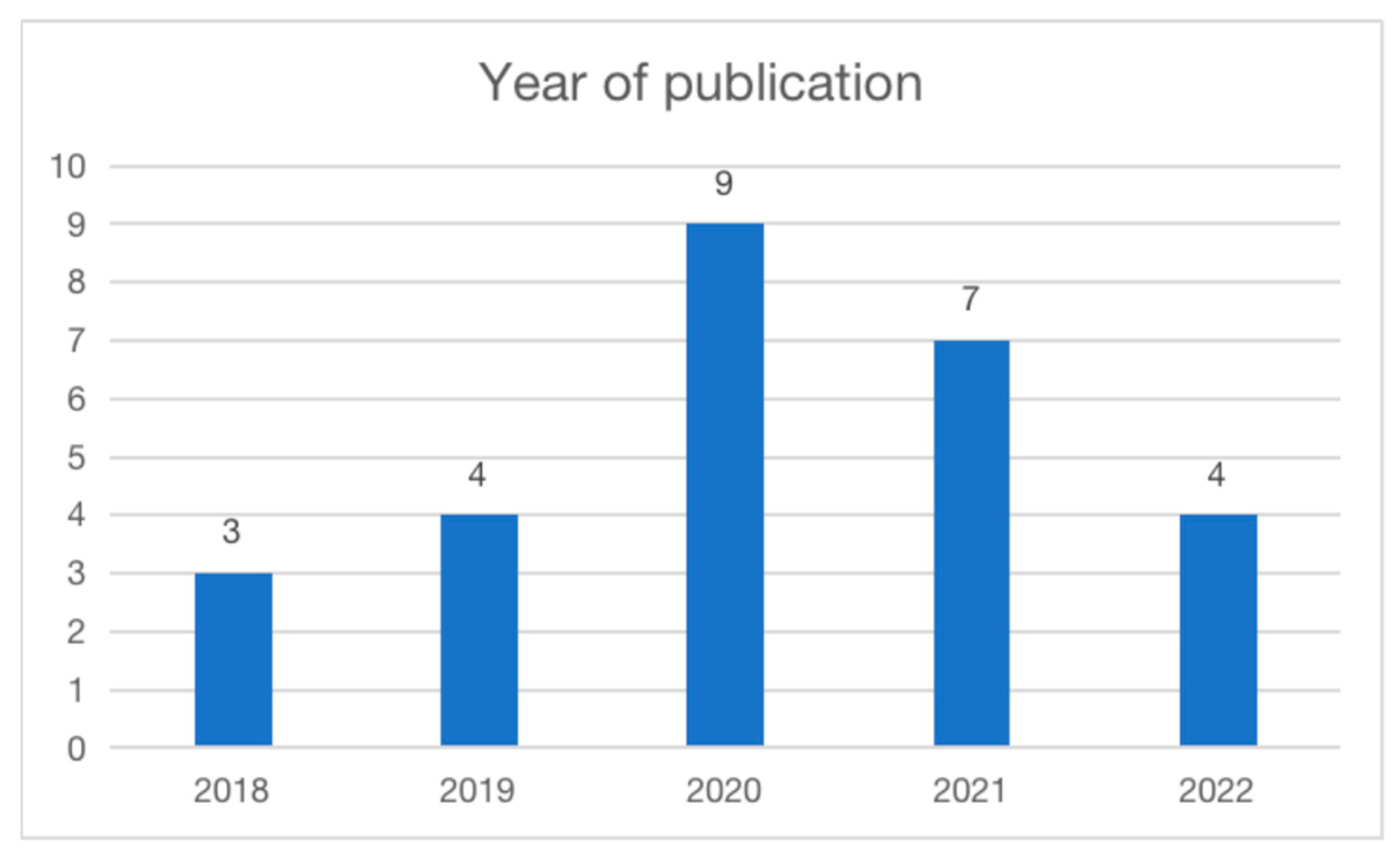
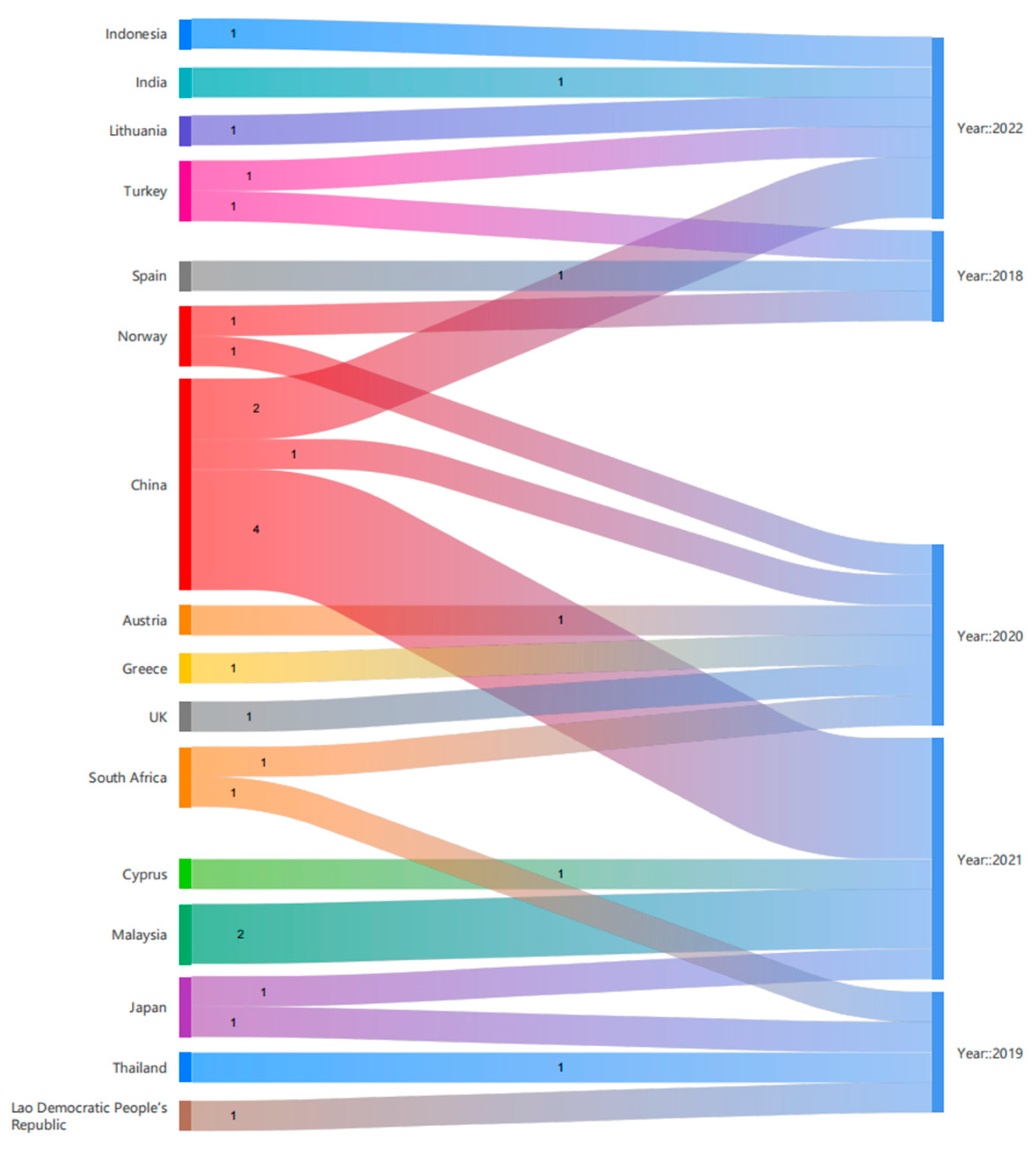

| Database | Search Strings | Results |
|---|---|---|
| Web of Science | TITLE: (souvenir) OR (“cultural product”) and “cultural heritage” and English (Language) and Articles OR Editorial Materials OR Review Articles (Document Types) and Hospitality Leisure Sport Tourism or Humanities Multidisciplinary or Art or Cultural Studies (Web of Science Category) Timespan: 2018–2022 | 160 results |
| Mendeley | “Cultural heritage” and “souvenir” AND DOCUMENT TYPE: Article YEAR: [2018 TO 2022] | 49 results |
| SCOPUS | TITLE-ABS-KEY (souvenir) OR TITLE-ABS-KEY (“cultural product”) AND TITLE–ABS–KEY (cultural AND heritage) AND LANGUAGE (English)) AND PUBYEAR > 2017 AND LIMIT-TO (DOCTYPE, “ar”) AND LIMIT-TO (SUBJAREA, “SOCI”) OR LIMIT-TO (SUBJAREA, “ARTS”) | 42 results |
| 2018 | 2019 | 2020 | 2021 | 2022 | Totals | |
|---|---|---|---|---|---|---|
| Transformation | 2 | 2 | 3 | 6 | 3 | 16 |
| Customer’s purchase intention | 1 | 1 | 2 | 1 | 2 | 7 |
| Significance of souvenirs | 0 | 1 | 2 | 1 | 1 | 5 |
| Sustainability | 0 | 0 | 0 | 2 | 2 | 4 |
| Totals | 3 | 4 | 7 | 10 | 8 | 32 |
| Significance of Souvenirs | Customer’s Purchase Intention | Transformation | Sustainability | |
|---|---|---|---|---|
| Ahmad (2021) [16] | √ | √ | ||
| Manola and Balermpas (2020) [6] | √ | |||
| Berjozkina and Karami (2021) [33] | √ | √ | ||
| Husa (2020) [13] | √ | √ | ||
| Jerlei (2022) [34] | √ | √ | ||
| Köse and Akbulut (2018) [35] | √ | |||
| Liang and Qi (2021) [12] | √ | |||
| Liu (2021) [32] | √ | |||
| Liu et al., (2019) [26] | √ | |||
| Liu et al., (2020) [36] | √ | |||
| Lopez-Guzman et al., (2018) [1] | √ | |||
| Ma et al., (2021) [20] | √ | |||
| Mathisen (2020) [4] | √ | |||
| Mayuzumi (2022) [27] | √ | √ | ||
| Mohale et al., (2020) [10] | √ | |||
| Olalere (2019) [5] | √ | |||
| Özgit et al., (2022) [22] | √ | |||
| Rahman et al., (2021) [37] | √ | |||
| Sawagvudcharee et al., (2020) [38] | √ | |||
| Schilar and Keskitalo (2018) [24] | √ | |||
| Sharma (2022) [7] | √ | |||
| Soukhathammavong and Park (2019) [15] | √ | |||
| Sun et al., (2022) [31] | √ | |||
| Tashi and Ullah (2019) [11] | √ | |||
| Wu et al., (2021) [19] | √ | |||
| Yotsumoto and Vafadari (2021) [25] | √ | |||
| Zhou and Pu (2022) [17] | √ |
| 2018 | 2019 | 2020 | 2021 | 2022 | |
|---|---|---|---|---|---|
| African Journal of Hospitality, Tourism and Leisure | 1 | 1 | |||
| American Journal of Industrial and Business Management | 1 | ||||
| Annals of Tourism Research | 1 | ||||
| Archives of Business Research | 1 | ||||
| Asia Pacific Journal of Tourism Research | 1 | ||||
| Asia-Pacific Journal of Regional Science | 1 | ||||
| International Journal of Design in Society | 1 | ||||
| International Journal of Early Childhood Special Education | 1 | ||||
| International Journal of Economics, Business and Management Research | 1 | ||||
| Journal of Cultural Heritage Management and Sustainable Development | 1 | ||||
| Journal of Heritage Tourism | 2 | ||||
| Journal of Material Culture | 1 | ||||
| Journal of Service Science and Management | 1 | ||||
| Journal of Sustainable Tourism | 1 | ||||
| Journal of Tourism and Cultural Change | 1 | ||||
| Modern Economy | 1 | ||||
| Religions | 1 | 2 | |||
| SMART MOVES JOURNAL IJELLH | 1 | ||||
| Symmetry | 1 | ||||
| Tourism Culture and Communication | 1 | ||||
| Tourism Management | 1 | ||||
| Webology | 1 | ||||
| WORLDWIDE HOSPITALITY AND TOURISM THEMES | 1 |
Disclaimer/Publisher’s Note: The statements, opinions and data contained in all publications are solely those of the individual author(s) and contributor(s) and not of MDPI and/or the editor(s). MDPI and/or the editor(s) disclaim responsibility for any injury to people or property resulting from any ideas, methods, instructions or products referred to in the content. |
© 2023 by the authors. Licensee MDPI, Basel, Switzerland. This article is an open access article distributed under the terms and conditions of the Creative Commons Attribution (CC BY) license (https://creativecommons.org/licenses/by/4.0/).
Share and Cite
Zhu, Q.; Rahman, R.; Alli, H.; Effendi, R.A.A.R.A. Souvenirs Development Related to Cultural Heritage: A Thematic Review. Sustainability 2023, 15, 2918. https://doi.org/10.3390/su15042918
Zhu Q, Rahman R, Alli H, Effendi RAARA. Souvenirs Development Related to Cultural Heritage: A Thematic Review. Sustainability. 2023; 15(4):2918. https://doi.org/10.3390/su15042918
Chicago/Turabian StyleZhu, Qiuxia, Rizal Rahman, Hassan Alli, and Raja Ahmad Azmeer Raja Ahmad Effendi. 2023. "Souvenirs Development Related to Cultural Heritage: A Thematic Review" Sustainability 15, no. 4: 2918. https://doi.org/10.3390/su15042918
APA StyleZhu, Q., Rahman, R., Alli, H., & Effendi, R. A. A. R. A. (2023). Souvenirs Development Related to Cultural Heritage: A Thematic Review. Sustainability, 15(4), 2918. https://doi.org/10.3390/su15042918





